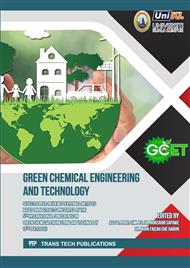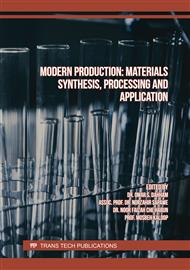[1]
W. Gindl-Altmutter, C. Fürst, A. raj Mahendran, M. Obersriebnig, G. Emsenhuber, M. Kluge, S. Veigel, J. Keckes, F. Liebner, Electrically conductive kraft lignin-based carbon filler for polymers, Carbon 89 (2015) 161-168.
DOI: 10.1016/j.carbon.2015.03.042
Google Scholar
[2]
T. L. Kelly-Yong, S. Lim, K. T. Lee, Gasification of oil palm Empty Fruit Bunch fibers in hot compressed water for synthesis gas production, J. Appl. Sci. 11 (2011) 3563–3570.
DOI: 10.3923/jas.2011.3563.3570
Google Scholar
[3]
T. L. K. Yong, M. Yukihiko, Kinetic analysis of guaiacol conversion in sub- and supercritical water, Ind. Eng. Chem. Res. 52 (2013) 9048–9059.
DOI: 10.1021/ie4009748
Google Scholar
[4]
T. L. K. Yong, Y. Matsumura, Reaction kinetics of the lignin conversion in supercritical water, Ind. Eng. Chem. Res. 51 (2012) 11975–11988.
DOI: 10.1021/ie300921d
Google Scholar
[5]
K. A. Khalid, A. A. Ahmad, T. L.-K. Yong, Lignin Extraction from Lignocellulosic Biomass Using Sub- and Supercritical Fluid Technology as Precursor for Carbon Fiber Production, J. Japan Inst. Energy 96 (2017) 255–260.
DOI: 10.3775/jie.96.255
Google Scholar
[6]
K. A. Khalid, V. Karunakaran, A. A. Ahmad, K. F. Pa'ee, N. Abd-Talib, and T. L. K. Yong, Lignin from oil palm frond under subcritical phenol conditions as a precursor for carbon fiber production, Malaysian J. Anal. Sci. 24 (2020) 484–494.
DOI: 10.1016/j.matpr.2020.01.252
Google Scholar
[7]
V. Karunakaran, N. Abd-Talib, T. L. Kelly Yong, Lignin from oil palm empty fruit bunches (EFB) under subcritical phenol conditions as a precursor for carbon fiber production, Mater. Today Proc. 31 (2020) 100–105.
DOI: 10.1016/j.matpr.2020.01.252
Google Scholar
[8]
D. Smink, A. Juan, B. Schuur, S. R. A. Kersten, Understanding the role of choline chloride in deep eutectic solvents used for biomass delignification, Ind. Eng. Chem. Res. 58 (2019) 16348–16357.
DOI: 10.1021/acs.iecr.9b03588
Google Scholar
[9]
D. Yongzhuang Liu, W. Chen, Q. Xia, B. Guo, Q. Wang, S. Liu, Y. Liu, J. Li, H. Yu, Efficient cleavage of lignin–carbohydrate complexes and ultrafast extraction of lignin oligomers from wood biomass by microwave-assisted treatment with deep eutectic solvent, ChemSusChem 10 (2017)1692–1700.
DOI: 10.1002/cssc.201601795
Google Scholar
[10]
K. H. Kim, T. Dutta, J. Sun, B. Simmons, S. Singh, Biomass pretreatment using deep eutectic solvents from lignin derived phenols, Green Chem. 20 (2018) 809–815.
DOI: 10.1039/c7gc03029k
Google Scholar
[11]
T. Li, G. Lyu, Y. Liu, R. Lou, L.A. Lucia, G. Yang, J. Chen, H.A. Saeed, Deep eutectic solvents (DESs) for the isolation of willow lignin (salix matsudana cv. zhuliu), Int. J. Mol. Sci. 18 (2017) 2266.
DOI: 10.3390/ijms18112266
Google Scholar
[12]
Q. Xia, Y. Liu, J. Meng, W. Cheng, W. Chen, S. Liu, Y. Liu, J. Li, H. Yu, Multiple hydrogen bond coordination in three-constituent deep eutectic solvents enhances lignin fractionation from biomass, Green Chem. 20 (2018) 2711–2721.
DOI: 10.1039/c8gc00900g
Google Scholar
[13]
C. Alvarez-Vasco, R. Ma, M. Quintero, M. Guo, S. Geleynse, K.K. Ramasamy, M. Wolcott, X. Zhang, Unique low-molecular-weight lignin with high purity extracted from wood by deep eutectic solvents (DES): A source of lignin for valorization, Green Chem. 18 (2016) 5133–5141.
DOI: 10.1039/c6gc01007e
Google Scholar
[14]
Y. T. Tan, G. C. Ngoh, A. S. M. Chua, Evaluation of fractionation and delignification efficiencies of deep eutectic solvents on oil palm empty fruit bunch, Ind. Crops Prod. 123 (2018) 271–277.
DOI: 10.1016/j.indcrop.2018.06.091
Google Scholar
[15]
M. Francisco, A. Van Den Bruinhorst, M. C. Kroon, New natural and renewable low transition temperature mixtures (LTTMs): Screening as solvents for lignocellulosic biomass processing, Green Chem. 14 (2012) 2153–2157.
DOI: 10.1039/c2gc35660k
Google Scholar
[16]
H. Malaeke, M. R. Housaindokht, H. Monhemi, M. Izadyar, Deep eutectic solvent as an efficient molecular liquid for lignin solubilization and wood delignification, J. Mol. Liq. 263 (2018) 193–199.
DOI: 10.1016/j.molliq.2018.05.001
Google Scholar
[17]
Y. T. Tan, G. C. Ngoh, A. S. M. Chua, Effect of functional groups in acid constituent of deep eutectic solvent for extraction of reactive lignin, Bioresour. Technol. 281 (2019) 359–366.
DOI: 10.1016/j.biortech.2019.02.010
Google Scholar
[18]
E. L. Smith, A. P. Abbott, K. S. Ryder, Deep eutectic solvents (DESs) and their applications, Chem. Rev. 114 (2014) 11060–11082.
DOI: 10.1021/cr300162p
Google Scholar
[19]
Q. Zhang, K.D.O. Vigier, S. Royer, F. Jérôme, Deep eutectic solvents: Syntheses, properties and applications, Chem. Soc. Rev. 41 (2012) 7108–7146.
DOI: 10.1039/c2cs35178a
Google Scholar
[20]
P. Kalhor, K. Ghandi, Deep eutectic solvents for pretreatment, extraction, and catalysis of biomass and food waste, Molecules 24 (2019) 4012.
DOI: 10.3390/molecules24224012
Google Scholar
[21]
Z. Maugeri, P. Domínguez De María, Novel choline-chloride-based deep-eutectic-solvents with renewable hydrogen bond donors: Levulinic acid and sugar-based polyols, RSC Adv. 2 (2012) 421–425.
DOI: 10.1039/c1ra00630d
Google Scholar
[22]
E. Abdulmalek, S. Zulkefli, M. Basyaruddin, A. Rahman, Deep eutectic solvent as a media in swelling and dissolution of oil palm trunk, Malaysian J. Anal. Sci. 21 (2017) 20-26.
DOI: 10.17576/mjas-2017-2101-03
Google Scholar
[23]
C. Cuissinat, P. Navard, T. Heinze, Swelling and dissolution of cellulose. Part IV: Free floating cotton and wood fibres in ionic liquids, Carbohydr. Polym. 72, (2008) 590–596.
DOI: 10.1016/j.carbpol.2007.09.029
Google Scholar
[24]
C. Li, C. Huang, Y. Zhao, C. Zheng, H. Su, L. Zhang, W. Luo, H. Zhao, S. Wang, L.J. Huang, Effect of choline-based deep eutectic solvent pretreatment on the structure of cellulose and lignin in bagasse, Processes 9 (2021) 384.
DOI: 10.3390/pr9020384
Google Scholar
[25]
T. Kanbayashi, H. Miyafuji, Effect of ionic liquid treatment on the ultrastructural and topochemical features of compression wood in Japanese cedar (Cryptomeria japonica), Sci. Rep. 6 (2016) 1–8.
DOI: 10.1038/srep30147
Google Scholar
[26]
A. Skulcova, A. Russ, M. Jablonsky, J. Sima, The pH behavior of seventeen deep eutectic solvents, Bioresources 3 (2018) 5042–5051.
DOI: 10.15376/biores.13.3.5042-5051
Google Scholar



